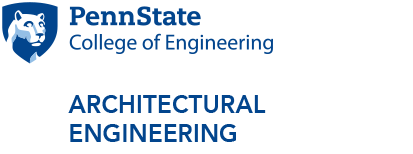
Susan Mohammed, Robert Leicht and Alan Wagner, left to right, stand behind a Husky by ClearPath Robotics, front left, which can move around rough terrain on construction sites and capture data, and a Pepper Robot by SoftBank Robotics, a service-oriented robot that can recognize human faces and have conversations. IMAGE: TYLER HENDERSON/PENN STATE
$1.5M grant will investigate use of robots on construction sites
11/8/2019
By Mariah Chuprinski
UNIVERSITY PARK, Pa. — Labor shortages, increasing demand and high accident and injury rates plague today’s construction industry. Robert Leicht, associate professor of architectural engineering, will lead a new $1.5 million grant from the National Science Foundation to investigate the use of robots on construction sites to provide needed relief for the waning workforce.
“Robotics in construction offers interesting opportunities for safety, since workers often are subject to dangerous working conditions,” Leicht said. “Construction workers are at risk for stress injuries from repetitive movements and physically intensive labor. There are ways to leverage robots to do the work that humans cannot — dangerous, repetitive work for 24 hours a day.”
As construction sites become more industrialized, Leicht explained, robots become more and more necessary for safety reasons. But while manufacturing robots tend to work in closed, static environments in a fixed position, construction robots must be mobile and work in a dynamic environment with weather conditions and people living and working near construction sites.
The three-year project involves five researchers, including Leicht. Joining him from Penn State are co-principal investigator Alan Wagner, assistant professor of aerospace engineering, and co-principal investigator Susan Mohammed, professor of psychology. Marissa Shuffler, associate professor of industrial psychology at Clemson University, and Bryan Franz, assistant professor in construction management at the University of Florida, round out the interdisciplinary team.
In the first phase of the project — led by Leicht and Wagner — the researchers will assemble a catalog of structured, clearly defined tasks that robots can perform on a jobsite.
“This catalog will help engineers, construction engineering firms and others decide if and how robots might be used to solve a wide variety of construction tasks,” Wagner said.
They also will develop an algorithm to relay detailed, step-by-step directions on how to complete a task, including the application of that task in an ever-changing construction site, in a language the robot can understand.
Finally, they will identify risks associated with using teams of robots and humans on shared construction sites, which are still dominated by human activities.
In phase two of the project, Mohammed and Shuffler will lead the development of a plan to facilitate efficient human-robot interaction on construction sites, with the goal of fully integrating robots into complex team structures.
They also will evaluate typical teaming patterns in construction tasks — building off the tasks catalog to be developed in phase one — to determine where robotics would fit into task-specific teams, according to Shuffler.
“We will specifically investigate the degree to which human trade works are ‘on the same page’ regarding the capabilities, coordination patterns and perceptions of robots in team dynamics, which has major implications for construction crew safety, efficiency and effectiveness,” Mohammed said.
A high-performing construction team must fully understand the work to be done, how to do it and when it is due, Mohammed explained. To successfully integrate robots into a construction site, the value of the robots must be incorporated into the team’s shared objectives to minimize risk.
“If workers overestimate what robots can do, safety can be compromised,” Mohammed said. “But if they underestimate what robots can do, the full benefit of the technology will not be harnessed to improve work efficiency.”
The third research phase, led by Franz, will investigate how robots are perceived among trade workers.
“Are robots perceived as servants to humans or more equal in status?” Franz asked. “When are they seen simply as a tool, no different than a hammer? And when are they seen as an active and reliable member of the crew?”
Franz also will determine what special accommodations might be needed to integrate robots on construction sites, like electrical power, routine maintenance tasks and sufficient operator knowledge.
“This is more difficult than it sounds,” Franz said. “We can easily ask a human worker what they need to complete their work, but we cannot, even with state-of-the-art technology, ask a robot to describe what and how much of something, like a certain resource or piece of information, it needs to function.”
Franz will develop a simulation to test a human-robot team’s resilience to disruptions and their ability to quickly react after experiencing common challenges or construction delays like late material deliveries, crew turnovers or routine equipment maintenance.
“The simulations will consider both the traditional jobsite, without robotic systems, and a jobsite that incorporates human-robot teams,” Franz said. “Taken together, these steps will achieve our goal of exploring the changing roles and interfaces of human and robot workers on industrialized construction jobsites.”
With these goals in mind, researchers said they hope to propel the United States to the next level when it comes to construction technology.
“Construction has remained remarkably slow in responding to automation that is standard in other industries,” said Sez Atamturktur, Harry and Arlene Schell Professor and head of the Department of Architectural Engineering. “Robotics has the potential to push the U.S. construction scene forward.”



